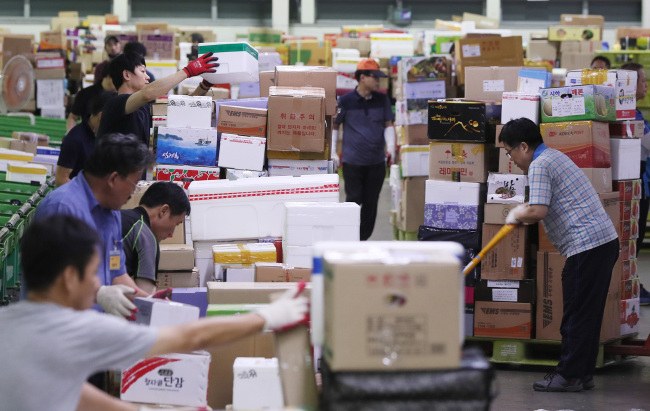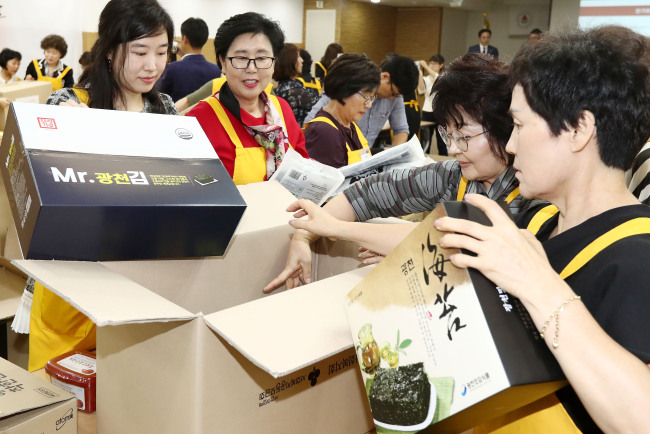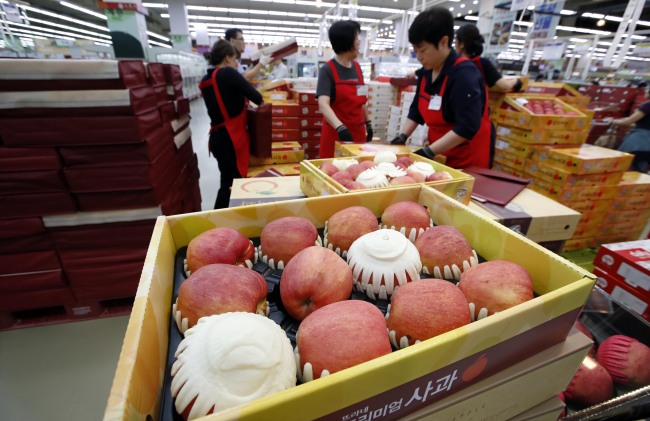[Feature] Consumers concerned about excessive packaging for Chuseok gifts
By Kim Da-solPublished : Oct. 1, 2017 - 12:16
For Kim Mi-hee, a 55-year-old housewife, it has become a routine recently for her to pick up Chuseok gift parcels from her doorstep, un pack them, and then lug cardboard boxes full of packing materials to her Seoul apartment block’s trash recycling area.
“I try my best to dutifully separate the recyclables from the garbage, but I did not know this much bubble wrap and Styrofoam was used in gift sets,” Kim said, adding that she often felt a sense of guilt and frustration when she opened the boxes.
“I try my best to dutifully separate the recyclables from the garbage, but I did not know this much bubble wrap and Styrofoam was used in gift sets,” Kim said, adding that she often felt a sense of guilt and frustration when she opened the boxes.

With Chuseok, or Lunar Thanksgiving, just around the corner, post offices and parcel service centers are at their busiest, with soaring delivery workloads for Korea’s second biggest national holiday.
For Chuseok holidays, people exchange gifts, mostly food, such as premium oils, dried fish sets, premium beef sets and health supplements, all going toward a family feast of traditional food.
Often taking up more than half of a product’s unit volume, data from the Korea Zero Waste Movement Network shows that product packaging accounted for nearly 60 percent of all household waste in 2014, almost double the equivalent figure of 35 percent in 2011.
Kim described receiving a Russian doll-type arrangement of boxes within boxes to protect a shampoo and conditioner set, with the bottles individually coddled in bubble wrap.

“For me, (Chuseok gifts) are not welcome. It rather means a hard work of removing paper, wrapping and plastic from the gift.”
Under regulations by the Environment Ministry, gift sets specially on sale for holiday season are recommended to be packaged twice at most.
Packing materials, such as plastic covers, polystyrene and bubble wrap must fill less than 25 percent of the package. Those who infringe the regulation can be fined up to 3 million won.
Department store operators say it costs at least 200 won (10 cents) to wrap each apple in a gift set box, while a typical box costs about 10,000 won.

Considering a gift box of apples is sold at 50,000 to 70,000 won at a department store, packaging costs account for 14-20 percent of the final price of the gift set.
Each year, the Environment Ministry and local governments launch campaigns at retail stores and distribution markets to prevent excessive packaging, but it is difficult to crack down on gift sets while they are on the shelf.
“Unless they unpack the wrapped gift sets, I think it will be hard for them to see the packaging,” said a housewife in her 40s who said she recently bought several boxes of anchovies for her husband’s employees.
Experts and civic groups say the government’s effort to crack down on excessive packaging should lead to actual legislation on curbing excessive packaging.
“Packaging materials, which are mostly plastic, aluminum and Styrofoam, which cannot be recycled, do greater than expected harm to the environment. That’s why simple, powerful solutions for reducing packaging waste are needed,” Ahn Seong-joon, an official from the Korea Environment Corp., told The Korea Herald.
What may be more necessary is the consumer’s voluntary efforts to oppose the culture of excess packaging.
“Moving away from excessive packaging doesn’t have to undermine convenience or the ability to maintain product freshness, particularly for food,” said Choi Hong-sik, an official from Seoul Metropolitan Government’s recycling bureau.
“Consumers should also put pressure on companies to reduce their environmental impact and go green, moving away from products made with unsustainable packaging practices.”
By Kim Da-sol (ddd@heraldcorp.com)




![[Herald Interview] 'Amid aging population, Korea to invite more young professionals from overseas'](http://res.heraldm.com/phpwas/restmb_idxmake.php?idx=644&simg=/content/image/2024/04/24/20240424050844_0.jpg&u=20240424200058)













![[KH Explains] Korean shipbuilding stocks rally: Real growth or bubble?](http://res.heraldm.com/phpwas/restmb_idxmake.php?idx=652&simg=/content/image/2024/04/25/20240425050656_0.jpg&u=)

